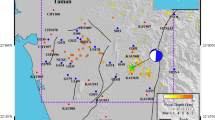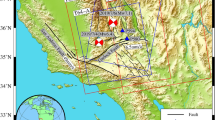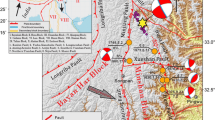Abstract
On January 8, 2022, the MS 6.9 Menyuan earthquake occurred in Menyuan, Qinghai province, China; the epicenter was on the fault terrace of the Lenglongling and Tuolaishan faults. To investigate the coseismic and pre-seismic deformation associated with the event, we constructed physical models using interferometric synthetic aperture radar (InSAR) and global navigation satellite system (GNSS) data and inverted the fault slip distribution, fault coupling fraction, fault slip deficit and strain rate. The primary inversion results were as follows: (1) The InSAR coseismic deformation pattern indicates that the left-lateral strike-slip deformation occurred in the NW–SE direction, with the maximum relative displacement in the line-of-sight direction being 1.3 m. (2) The coseismic slip mainly occurred in a 30 × 25 km region at a depth of 0–8 km. The maximum fault slip was 3.81 m with a moment magnitude (MW) of 6.6. (3) Based on the fault coupling inversion, the seismogenic fault was strongly locked (> 0.96) up to a depth of ~ 10 km before the Menyuan earthquake. The coseismic rupture zone in the fault strike direction was significantly smaller than the pre-seismic locked region. (4) The pre-seismic strain rates revealed NE–SW compressive and NW–SE tensile deformations, reflecting a considerable left-lateral strain accumulation in the seismogenic region, with a maximum shear strain rate of 2.6 × 10–8/year. Therefore, attention must be paid to the seismic hazards posed by the Tuolaishan and Lenglongling faults adjacent to the seismogenic region.









Similar content being viewed by others
References
Avouac, J. P., Meng, L. S., Wei, S. J., Wang, T., & Ampuero, J. P. (2015). Lower edge of locked Main Himalayan Thrust unzipped by the 2015 Gorkha earthquake. Nature Geoscience, 8, 708–711.
Chen, C. W. (2001). Statistical-cost network-flow approaches to two- dimensional phase unwrapping for radar interferometry. Stanford University.
Chen, W. T., Gan, W. J., & Xiao, G. R. (2017). The regional crustal deformation before the 2016 Menyuan MS6.4 earthquake. Journal of Geodesy and Geodynamics, 37(8), 777–781.
China Earthquake Networks Center, (2022). https://www.cenc.ac.cn/cenc/dzxx/396391/index.html
Fan, L. P., Li, B. R., Liao, S. R., Jiang, C., & Fang, L. H. (2022). High-precision relocation of the aftershock sequence of the January 8, 2022, MS6.9 Menyuan earthquake. Earthquake Science. https://doi.org/10.1016/j.eqs.2022.01.021
Gan, W. J., Zhang, P. Z., Shen, Z. K., Niu, Z. J., Wang, M., Wan, Y., Zhou, D. M., & Cheng, J. (2007). Present-day crustal motion within the Tibetan Plateau inferred from GPS measurements. Journal of Geophysical Research. https://doi.org/10.1029/2005JB004120
Gaudemer, Y., Tapponnier, P., Meyer, B., Peltzer, G., Guo, S. M., Chen, Z. T., Dai, H., & Cifuentes, I. (1995). Partitioning of crustal slip between linked, active faults in the eastern Qilian Shan, and evidence for a major seismic gap, the ‘Tianzhu gap’, on the western Haiyuan Fault, Gansu (China). Geophysical Journal International, 120(3), 599–645.
Ge, W. P., Molnar, P., Shen, Z. K., & Li, Q. (2015). Present-day crustal thinning in the southern and northern Tibetan Plateau revealed by GPS measurements. Geophysical Research Letters, 42(13), 5227–5235.
Guo, P., Han, Z. J., An, Y. F., Jiang, W. L., Mao, Z. B., & Feng, W. (2017). Activity of the Lenglongling fault system and seismotectonics of the 2016 Ms6.4 Menyuan earthquake. Science China Earth Sciences, 47(5), 617–630.
Global Centroid Moment Tensor (2022). Global CMT catalog search. [2021–01–07]. https://www.globalcmt.org/CMTsearch.html.
He, W. G., Liu, B. C., Yuan, D. Y., & Yang, M. (2000). Research on slip rates of the Lenglongling active fault zone. North-Western Seismological Journal, 22(1), 90–97.
Hu, C. Z., Yang, P. X., Li, Z. M., Huang, S. T., Zhao, Y., Chen, D., Xiong, W. R., & Chen, Y. Q. (2016). Seismogenic mechanism of the 21 January 2016 Menyuan, Qinghai Ms6.4 earthquake. Chinese Journal of Geophysics, 59(5), 1637–1646.
Ji, L. Y., Liu, C. J., Xu, J., Liu, L., Long, F., & Zhang, Z. W. (2017). InSAR observation and inversion of the seismogenic fault for the 2017 Jiuzhaigou Ms7.0 earthquake in China. Chinese Journal of Geophysics, 60(10), 4069–4082.
Li, Q., Jiang, Z. S., Wu, Y. Q., & Zhao, J. (2014). Inversion of locking and listribution of slip deficit in Haiyuan-Liupan fault zone using GPS data. Geomatics and Information Science of Wuhan University, 39(5), 575–580.
Li, Y., Liu, X., Liu, X. K., Zhou, W., Zheng, Z., Zhang, L., Du, X., & Shen, X. (2016a). Activity analysis of faults around Qilianshan before the 2016 Menyuan Ms6.4 earthquake. Journal of Geodesy and Geodynamics, 36(4), 288–293.
Li, Y., Shan, X., Qu, C., & Wang, Z. (2016b). Fault locking and slip rate deficit of the Haiyuan-Liupanshan fault zone in the northeastern margin of the Tibetan plateau. Journal of Geodynamics, 102, 47–57.
Li, Y., Shan, X., Qu, C., Zhang, Y., Song, X., Jiang, Y., Zhang, G., Nocquet, J. M., Gong, W., Gan, W., & Wang, C. (2017). Elastic block and strain modeling of GPS data around the Haiyuan-Liupanshan fault, northeastern Tibetan plateau. Journal of Asian Earth Sciences, 150, 87–97.
Li, Z. H., Han, B. Q., Liu, Z. J., Zhang, M. M., Yu, C., Chen, B., Liu, H. H., Du, J., Zhang, S. C., Zhu, W., Zhang, Q., & Peng, J. B. (2022). Source parameters and slip distributions of the 2016 and 2022 Menyuan, Qinghai earthquakes constrained by InSAR observations. Geomatics and Information Science of Wuhan University. https://doi.org/10.1320/j.whugis20220037
Loveless, J., & Meade, B. (2011). Spatial correlation of interseismic coupling and coseismic rupture extent of the 2011 Mw=9.0 Tohokuoki earthquake. Geophysical Research Letters, 38(17), L17306.
Mao, A., Harrison, C. G. A., & Dixon, T. H. (1999). Noise in GPS coordinate time series. Journal of Geophysical Research, 104(B2), 2797–2816.
McCaffrey, R. (2002). Crustal block rotations and plate coupling. In: Stein, S., Freymueller, J.T. (Eds.), Plate Boundary Zones, AGU Geodynamics Series, 30, Washington D.C. pp. 101–122.
McCaffrey, R. (2005). Block kinematics of the Pacific-North America plate boundary in the southwestern United States from inversion of GPS, seismological, and geologic data. Journal of Geophysical Research. https://doi.org/10.1029/2004JB003307
Moreno, M., Rosenau, M., & Oncken, O. (2010). 2010 Maule earthquake slip correlates with pre-seismic locking of Andean subduction zone. Nature, 467(7312), 198–202.
Okada, Y. (1992). Internal deformation due to shear and tensile faults in a half-space. Bulletin of the Seismological Society of America, 82(2), 1018–1040.
Peng, Z., Liu-Zeng, J., Deng, Y.,& Toda, S. (2022). Strong earthquake increases seismic hazard in Qinghai, China, Temblor. https://doi.org/10.32858/temblor.230
Qu, C., Zhang, G., Shan, X., Zhang, G., Song, X., & Liu, Y. (2013). Coseismic deformation derived from analyses of C and L band SAR data and fault slip inversion of the Yushu Ms7.1 earthquake, China in 2010. Tectonophysics, 584, 119–128.
Sandwell D, Mellors R, Tong X, Wei, M.,& Wessel, P. (2011). GMTSAR: An InSAR processing system based on generic mapping tools. Technical Report. Scripps Institution of Oceanography, UC San Diego.
Schurr, B., Asch, G., Hainzl, S., Bedford, J., Hoechner, A., Palo, M., Wang, R. J., Moreno, M., Bartsch, M., Zhang, Y., Oncken, O., Tilmann, F., Dahm, T., Victor, P., Barrientos, S., & Vilotte, J. (2014). Gradual unlocking of plate boundary controlled initiation of the 2014 Iquique earthquake. Nature, 512(7514), 299–302.
Shan, X. J., Qu, C. Y., Gong, W. Y., Zhao, D. Z., Zhang, F. Y., Zhang, G. H., Song, X. G., Liu, Y. H., & Zhang, G. F. (2017). Coseismic deformation field of the Jiuzhaigou Ms7.0 earthquake from Sentinel-1A InSAR data and fault slip inversion. Chinese Journal of Geophysics, 60(12), 4527–4536.
USGS (2022). USGS CMT catalog. [2022–01–07]. https://earthquake.usgs.gov/earthquakes/eventpage/us7000g9zq/moment-tensor
Wang, R. Jt., Motagh, M. & Walter, T. R. (2008). Inversion of slip distribution from seismic deformation data by a Sensitivity Based Iterative Fitting (SBIF) method. //EGU General Assembly 2008. Vienna, Austria: EGU.
Wang, M., & Shen, Z. K. (2020). Present day crustal deformation of continental China derived from GPS and its tectonic implications. Journal of Geophysical Research: Solid Earth, 125(2), e2019JB018774.
Wang, H., Ge, L., Xu, C., & Du, Z. (2007). 3-D coseismic displacement field of the 2005 Kashmir earthquake inferred from satellite radar imagery. Earth, Planets and Space, 59, 343–349.
Wang, H., Liu, M., Cao, J., Shen, X., & Zhang, G. (2011). Slip rates and seismic moment deficits on major active faults in mainland China. Journal of Geophysical Research Solid Earth. https://doi.org/10.1029/2010JB007821
Wang, H., Liu-Zeng, J., Ng, A. H. M., Ge, L., Javed, F., Long, F., Aoudia, A., Feng, J., & Shao, Z. (2017). Sentinel-1 observations of the 2016 Menyuan earthquake: A buried reverse event linked to the left-lateral Haiyuan fault. International Journal of Applied Earth Observation and Geoinformation, 61, 14–21.
Wang, Q., Niu, F., Gao, Y., & Chen, Y. (2016). Crustal structure and deformation beneath the NE margin of the Tibetan plateau constrained by teleseismic receiver function data. Geophysical Journal International, 204(1), 167–179.
Wang, X. S., Fang, J., & Hsu, H. T. (2013). 3D density structure of lithosphere beneath northeastern margin of the Tibetan Plateau. Chinese Journal of Geophysics, 56(11), 3770–3778.
Wu, Y., Jiang, Z., Liang, H., Chang, L., Chen, C., Zhu, S., Zhao, J., & Du, J. (2016). Coseismic deformations of the 2015 MW 7.8 Gorkha earthquake and pre-seismic strain accumulation in the Himalayan tectonic belt and Tibetan plateau. Tectonophysics, 670, 144–154.
Wu, Y., Jiang, Z., Pang, Y., & Chen, C. (2021). Statistical correlation of seismicity and geodetic strain rate in the Chinese mainland. Seismological Research Letters, 93(1), 268–276.
Wu, Y. Q., Jiang, Z. S., Wang, M., Che, S., Liao, H., Li, Q., Li, P., Yang, Y. L., Xiang, H. P., Shao, Z. G., Wang, W. X., Wei, W. X., & Liu, X. X. (2013). Preliminary results of the co-seismic displacement and pre-seismic strain accumulation of the Lushan MS7.0 earthquake reflected by the GPS surveying. Chinese Science Bulletin, 58(28–29), 1910–1916.
Wu, Y., Jiang, Z., Yang, G., Fang, Y., & Wang, X. (2009). The application and method of GPS strain calculation in whole mode using least square collocation in sphere surface. Chinese Journal of Geophysics, 52(7), 1707–1724.
Wu, Y., Jiang, Z., Yang, G., Wei, W., & Liu, X. (2011). Comparison of GPS strain rate computing methods and their reliability. Geophysical Journal International, 185(2), 703–717.
Wu, Y. Q., Jiang, Z. S., Zhao, J., Liu, X. X., Wei, W. X., Liu, Q., Li, Q., Zou, Z. Y., & Zhang, L. (2015). Crustal deformation before the 2008 Wenchuan Ms8.0 earthquake studied using GPS data. Journal of Geodynamics, 85, 11–23.
Xu, X., Sandwell, D. T., Tymofyeyeva, E., Gonzalez-Ortega, A., & Tong, X. (2017). Tectonic and anthropogenic deformation at the Cerro Prieto geothermal step-over revealed by Sentinel-1A InSAR. IEEE Transactions on Geoscience and Remote Sensing, 55, 5284–5292.
Yang, H., Wang, D., Guo, R., Xie, M., Zang, Y., Wang, Y., Yao, Q., Cheng, C., An, Y., & Zhang, Y. (2022). Rapid report of the 8 January 2022 MS6.9 Menyuan earthquake, Qinghai, China. Earthquake Research Advances. https://doi.org/10.1016/j.eqrea.2022.100113
Yuan, D. Y. (2022). Qinghai Menyuan M6.9 earthquake site inspection results released. https://t.ynet.cn/baijia/32080013.html. (Accessed 18 January 2022)
Yuan, D. Y., Zhang, P. Z., Liu, B. C., Gan, W. J., Mao, F. Y., Wang, Z. C., Zheng, W. J., & Guo, H. (2004). Geometrical imagery and tectonic transformation of late quaternary active tectonics in Northeastern margin of Qingha-Xizang plateau. Acta Geologica Sinica, 78(2), 270–278.
Zhao, J., Niu, A. F., Li, Q., & Yuan, Z. Y. (2016). Study on dynamic characteristics of fault locking and fault slip deficit in the faults around the Longxi block. Journal of Seismological Research, 39(3), 351–358.
Zhao, J., Ren, J., Liu, J., Jiang, Z., Liu, X., Liang, H., Niu, A., Yue, C., & Yuan, Z. (2020). Coupling fraction and relocking process of the Longmenshan fault zone following the 2008 Mw7.9 Wenchuan earthquake. Journal of Geodynamics, 137, 101730.
Acknowledgements
The authors are grateful to the editor and two anonymous reviewers for their constructive comments on our manuscript. Thanks a lot for the helpful advice from Jing Zhao (China Earthquake Networks Center) and Qiang Li (Fujian Earthquake Agency). The authors would also like to thank the European Space Agency (ESA) for providing the Sentinel-1 data. We used the GMT5SAR software to generate InSAR data. This work was supported by the National Key R&D Program of China (grant number 2017YFC1500501); National Natural Science Foundation of China (grant nos. 41974011); Science and Technology Innovation Fund of the First Monitoring and Application Center, China Earthquake Administration (grant no. FMC2022002); Scientific Research Project Coordinating Fund of the First Monitoring and Application Center, China Earthquake Administration (grant no. FMC2022016).
Author information
Authors and Affiliations
Contributions
NG: writing—review and editing. YW: conceptualization, methodology. QZ: validation.
Corresponding author
Ethics declarations
Conflict of Interest
The authors declare that they have no known competing financial interests or personal relationships that could have appeared to influence the work reported in this paper.
Additional information
Publisher's Note
Springer Nature remains neutral with regard to jurisdictional claims in published maps and institutional affiliations.
Rights and permissions
Springer Nature or its licensor holds exclusive rights to this article under a publishing agreement with the author(s) or other rightsholder(s); author self-archiving of the accepted manuscript version of this article is solely governed by the terms of such publishing agreement and applicable law.
About this article
Cite this article
Guo, N., Wu, Y. & Zhang, Q. Coseismic and Pre-seismic Deformation Characteristics of the 2022 MS 6.9 Menyuan Earthquake, China. Pure Appl. Geophys. 179, 3177–3190 (2022). https://doi.org/10.1007/s00024-022-03128-3
Received:
Revised:
Accepted:
Published:
Issue Date:
DOI: https://doi.org/10.1007/s00024-022-03128-3




